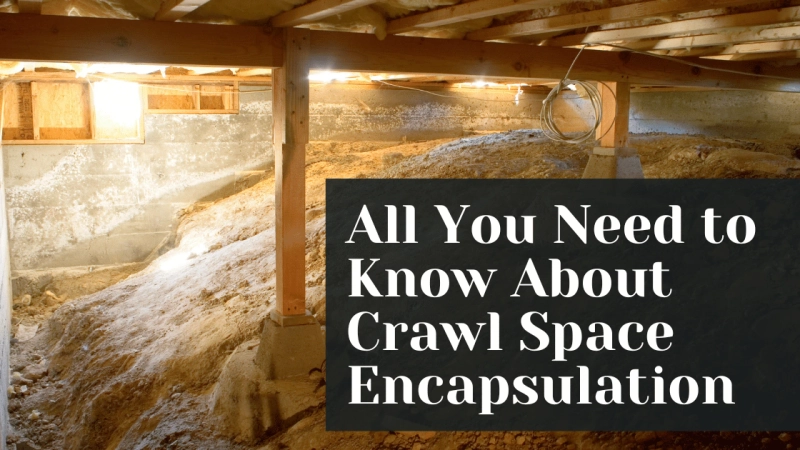Crawl space encapsulation is a crucial process for maintaining a healthy, energy-efficient, and structurally sound home. By sealing off the crawl space from outside moisture, pests, and other harmful elements, homeowners can avoid numerous issues that could compromise their property. This article will cover everything you need to know about crawl space encapsulation, including its benefits, the process, costs, and frequently asked questions.
What is Crawl Space Encapsulation?
Crawl space encapsulation involves sealing the crawl space beneath your home with a heavy-duty moisture barrier, insulation, and a dehumidifier. This process is designed to prevent moisture, pests, and other unwanted elements from entering the crawl space, thereby protecting the home’s foundation and improving indoor air quality.
Key Components of Crawl Space Encapsulation
- Moisture Barrier: A thick, durable plastic sheet is laid across the floor and walls of the crawl space to block moisture from the ground.
- Sealing Vents: Any vents or openings to the outside are sealed to prevent air and pests from entering.
- Insulation: Insulating the walls of the crawl space helps regulate the temperature, reducing energy costs.
- Dehumidifier: A dehumidifier is installed to control humidity levels and prevent mold growth.
Benefits of Crawl Space Encapsulation
1. Moisture Control
Encapsulation effectively prevents moisture from entering the crawl space, reducing the risk of mold, mildew, and wood rot. This is crucial for maintaining the structural integrity of your home.
2. Improved Air Quality
By sealing off the crawl space, you prevent mold spores and other allergens from circulating in your home, leading to better indoor air quality.
3. Energy Efficiency
Insulating the crawl space can help reduce heating and cooling costs by preventing outside air from affecting the temperature inside your home.
4. Pest Prevention
Sealing the crawl space keeps out pests like rodents and insects, which can cause damage and bring disease.
5. Increased Home Value
Homes with encapsulated crawl spaces are often seen as more valuable because they are better protected against moisture and pests, which are common problems in many areas.
The Crawl Space Encapsulation Process
1. Inspection
A professional will inspect your crawl space to assess its condition, identify any existing issues, and determine the materials and methods needed for encapsulation.
2. Cleaning and Repair
Before encapsulation, any standing water, debris, mold, or damage must be addressed. This may include repairing leaks, treating mold, and replacing damaged insulation.
3. Installing the Moisture Barrier
A high-quality polyethylene vapor barrier is installed over the floor and walls, completely sealing the area from the ground up. The seams are taped to ensure no gaps.
4. Sealing Vents and Openings
All vents, gaps, and openings to the outside are sealed to prevent air and moisture from entering the crawl space.
5. Insulation Installation
Insulation is added to the walls and sometimes the floor to help maintain a consistent temperature.
6. Dehumidifier Installation
A dehumidifier is installed to control humidity levels, preventing mold growth and maintaining a dry environment.
7. Final Inspection
A final inspection ensures that the encapsulation has been done correctly and that the crawl space is fully protected.
Cost of Crawl Space Encapsulation
The cost of crawl space encapsulation can vary widely based on the size of the space, the materials used, and the extent of any necessary repairs. On average, homeowners can expect to pay between $5,000 and $15,000 for a complete encapsulation. While this may seem like a significant investment, the long-term benefits, including energy savings and avoided repair costs, often outweigh the initial expense.
Crawl Space Encapsulation in St. Louis with Air Sense Environmental
If you\'re a homeowner in St. Louis, Air Sense Environmental offers expert Crawl Space Encapsulation in St. Louis designed to protect your home from the region\'s unique climate challenges. St. Louis experiences a mix of hot, humid summers and cold winters, which can lead to moisture buildup and fluctuating temperatures in your crawl space. Air Sense Environmental specializes in creating customized encapsulation solutions that address these issues, enhancing your home\'s energy efficiency, indoor air quality, and structural integrity. With a focus on quality materials and professional installation, they ensure your crawl space remains dry, clean, and free from pests, providing long-term peace of mind.
Conclusion
Crawl space encapsulation is an effective way to protect your home from moisture, pests, and structural damage. It enhances air quality, boosts energy efficiency, and can even increase the value of your property. By understanding the process and its benefits, you can make an informed decision about whether crawl space encapsulation is right for your home.



